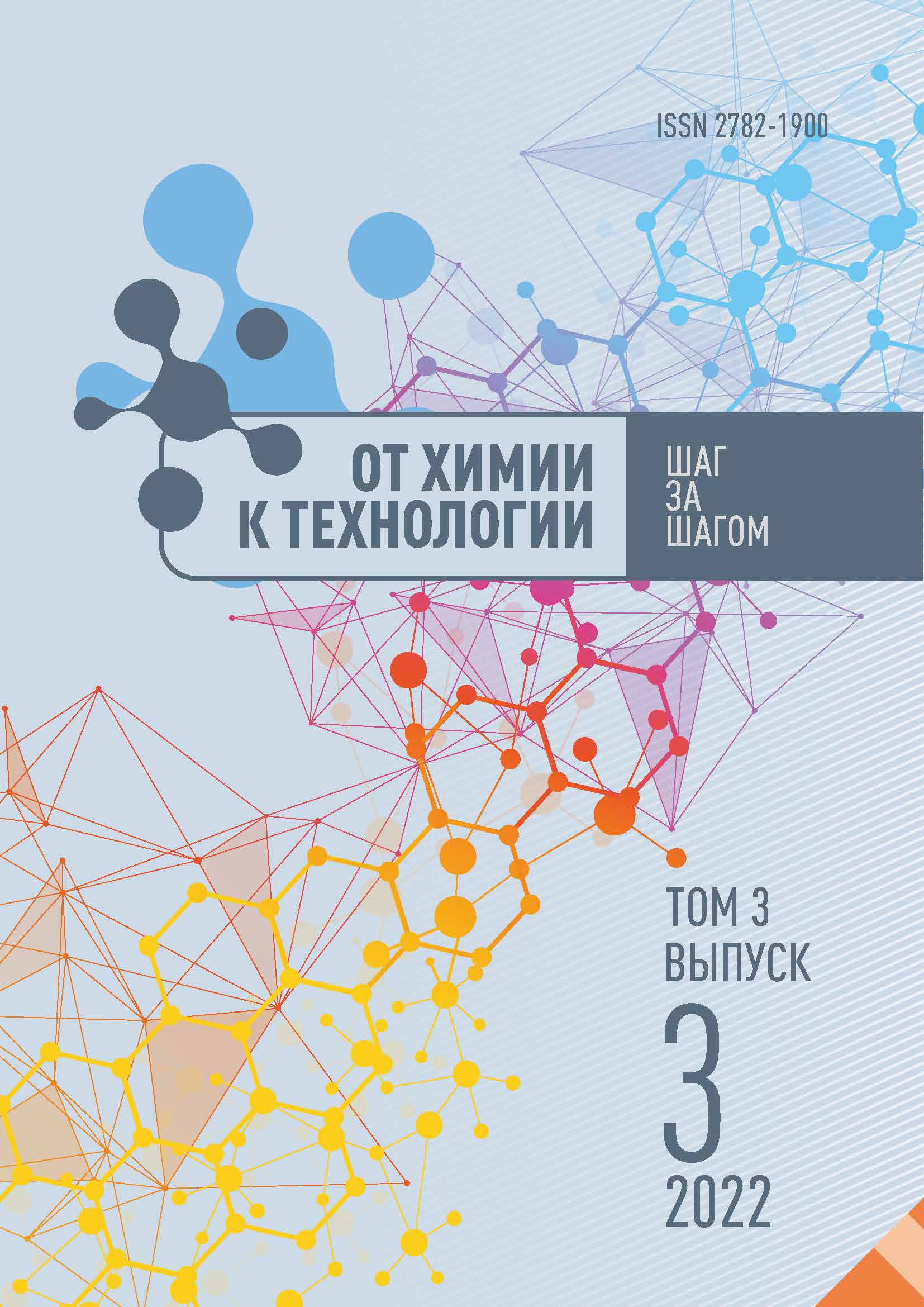Ivanovo, Ivanovo, Russian Federation
Ivanovo, Ivanovo, Russian Federation
Ivanovo, Ivanovo, Russian Federation
This paper studies the process of Cu(II) ions extraction from aqueous solutions by cellulose-containing sorbents: native and modified by L-arginine flax fiber. We processed the experimental kinetic curves of copper ion sorption by pseudo-first and pseudo-second order models and obtain a high correlation coefficient (0.99) when used a pseudo-second order kinetics model. The results of the treatment of the sorption isotherms according to the Langmuir model indicate the model capability for the description of the process of copper ions sorption by cellulose sorbents. As a result of two-stage chemical modification through the oxidation stage of linen fibre with sodium periodate and subsequent modification with L-arginine, we obtain a new sorbent, which can be used to purify aqueous solutions from heavy metal ions. The paper also presents SEM images and elemental analysis of original and modified flax fibre samples. The infrared spectra confirms the changes occurred in the linen fibre during modification. The obtained sorbent significantly surpasses the native linen fibre in its sorption characteristics, as evidenced by the values of the ultimate sorption capacity.
flax fibre, modification, L-arginine, sodium metaperiodate, sorption, Cu(II) ions
1. Vardhan K.H., Kumar P.S., Panda R.C. A review on heavy metal pollution, toxicity and remedial measures: current trends and future perspectives // J. Mol. Liq. 2019. Vol. 290. 111197. DOI:https://doi.org/10.1016/j.molliq.2019.111197.
2. Lindholm-Lehto P. Biosorption of heavy metals by lignocellulosic biomass and chemical analysis // BioRes. 2019. Vol. 14(2). P. 4952–4995. DOI:https://doi.org/10.15376/biores.14.2.Lindholm-Lehto.
3. Yadav S., Yadav A., Bagotia N., Sharma A.K., Kumar S. Adsorptive potential of modified plant-based adsorbents for sequestration of dyes and heavy metals from wastewater - A review // Journal of Water Process Engineering. 2021. Vol. 42. P. 102-148. DOI:https://doi.org/10.1016/j.jwpe.2021.102148
4. Tursi A. A review on biomass: importance, chemistry, classification, and conversion // Biofuel Res. J. 2019. Vol. 6, P. 962–979. DOI:https://doi.org/10.18331/BRJ2019.6.2.3.
5. Joseph L., Jun B.-M., Flora J.R.V., Park C.M., Yoon Y. Removal of heavy metals from water sources in the developing world using low-cost materials: a review // Chemosphere. 2019. Vol. 229. P. 142-159. DOI:https://doi.org/10.1016/j.chemosphere.2019.04.198.
6. Ravikumar L. The Use of New Chemically Modified Cellulose for Heavy Metal Ion Adsorption and Antimicrobial Activities // Journal of Water Resource and Protection. 2015. № 7(06). S. 530-545. DOI:https://doi.org/10.4236/jwarp.2015.76042
7. Nikiforova T.E., Kozlov V.A., Loginova V.A. Peculiarities of the adsorption of heavy-metal ions from aqueous media by modified cellulose // Adsorption Science & Technology. 2014. Vol. 32, № 5. R. 389-402. DOI:https://doi.org/10.1260/0263-6174.32.5.389.
8. Lindholm-Lehto P. Biosorption of heavy metals by lignocellulosic biomass and chemical analysis // BioRes. 2019. Vol. 14(2). P. 4952–4995. DOI:https://doi.org/10.15376/biores.14.2.Lindholm-Lehto.
9. Ali A., Mannan A., Hussain I., Hussain I. Effective removal of metal ions from aquous solution by silver and zinc nanoparticles functionalized cellulose: Isotherm, kinetics and statistical supposition of process // Environmental Nanotechnology Monitoring & Managemen. 2017. № 9. R.1-11. DOI:https://doi.org/10.1016/j.enmm.2017.11.003.
10. Meretin R.N., Nikiforova T.E. Investigation of the reactivity of the surface of a carbon-containing silicate sorbent of plant origin // ChemChemTech [Izv. Vyssh. Uchebn. Zaved. Khim. Khim. Tekhnol.]. 2021. Vol. 64, № 11. P. 147-155. DOI:https://doi.org/10.6060/ivkkt.20216411.6408
11. Nikiforova T.E., Vokurova D.A. Sorbciya ionov tyazhelyh metallov cellyuloznym sorbentom iz vodnyh rastvorov // Ot himii k tehnologii shag za shagom. 2022. T. 3, vyp. 1. S. 8-20. URL: http://chemintech.ru/index.php/tor/2022tom3no1
12. Kumar R., Sharma R.Kr., Singh A.P. Cellulose based grafted biosorbents - Journey from lignocellulose biomass to toxic metal ions sorption applications - A review // Journal of Molecular Liquids. 2017. Vol. 232. P. 62 93. DOI: http://dx.doi.org/10.1016/j.molliq.2017.02.050
13. Podstawczyka D., Witek-Krowiak A., Dawieca A., Bhatnagar A. Biosorption of copper(II) ions by flax meal: Empirical modeling and process optimization by response surface methodology (RSM) and artificial neural network (ANN) simulation // Ecological Engineering. 2015. Vol. 83. P. 364-379. URL: https://doi.org/10.1016/j.ecoleng.2015.07.004
14. Kajeiou M., Alem A., Mezghich S., Ahfir N.-D., Mignot M., Devouge-Boyer C., Pantet A. Competitive and non-competitive zinc, copper and lead biosorption from aqueous solutions onto flax fibers // Chemosphere. 2020. Vol. 260. P. 127-505. URL: https://doi.org/10.1016/j.chemosphere.2020.127505
15. Dey P., Mahapatra B.S., Juyal V.K., Pramanick B., Negi M.S., Paul J., Singh S.P. Flax processing waste – A low-cost, potential biosorbent for treatment of heavy metal, dye and organic matter contaminated industrial wastewater // Industrial Crops & Products. 2021. Vol. 174. P. 114-195. DOI: https://doi.org/10.1016/j.indcrop.2021.114195
16. Abbar B., Alem A., Marcotte S., Pantet A., Ahfi N.-D., Bizet L., Duriatti D. Experimental investigation on removal of heavy metals (Cu2+, Pb2+, and Zn2+) from aqueous solution by flax fibres // Process Safety and Environmental Protection. 2017. Vol. 109. P. 639–647. DOI: http://dx.doi.org/10.1016/j.psep.2017.05.012.
17. Nikiforova T.E., Kozlov V.A., Natareev S.V., Dubkova E.A. Vliyanie plazmennogo modificirovaniya na sorbcionnye svoystva l'nyanogo volokna // Izv. vuzov. Himiya i him. tehnologiya. 2014. T.57, vyp. 3. S. 91-97.
18. Nikiforova T.E., Kozlov V.A., Odintsova O.I. Regularities of Copper (II) and Nickel (II) Distribution in an Aqueous Solution ‒ Modified Flax Fiber Heterophase System // Russian Journal of General Chemistry. 2017. Vol. 87, № 9. R. 2204-2211. DOI:https://doi.org/10.1134/S107036321709047H.
19. Krichevskiy G.E. Himicheskaya tehnologiya tekstil'nyh materialov: uchebnik dlya vuzov. V 3 t. T. 1. Teoreticheskie osnovy tehnologii. Volokna. Zagryazneniya. Podgotovka tekstil'nyh materialov. M.: RosZITLP, 2000. 436 s.







